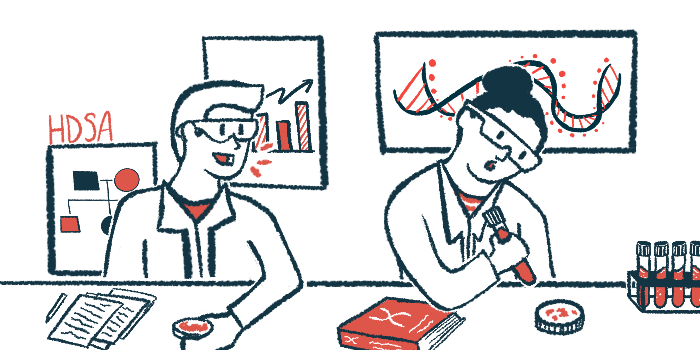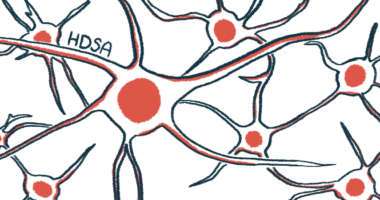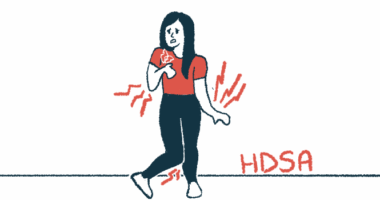HDSA 2024: Huntington’s disease clinical trials enrolling in US
Trials will test either tominersen or dalzanemdor in patients

Clinical trials testing either tominersen, an experimental therapy designed to target the underlying cause of Huntington’s disease, or dalzanemdor, an oral candidate that aims to improve cognitive abilities, are currently enrolling Huntington’s patients in the U.S.
Updates on the therapies’ clinical programs were provided by representatives of their respective developers during a clinical trials lunch at the Huntington’s Disease Society of America annual convention, held May 30-June 1 in Spokane, Washington.
Huntington’s is caused by mutations in the HTT gene, which results in the production of an abnormal form of the huntingtin protein that is thought to drive nerve cell death and Huntington’s symptoms.
Roche’s tominersen, administered into the spinal canal to reach the brain, is an RNA-based medication that’s designed to reduce levels of both normal and mutated forms of the huntingtin protein.
Data from proof-of-concept trials have indicated that the therapy effectively lowers abnormal huntingtin levels as designed.
“To this day, tominersen is the only drug that’s been able to do this,” said Rita Gandhy, MD, a movement disorders neurologist and senior medical director of global product development at Roche.
Potential benefit for younger patients
A previous Phase 3 trial called GENERATION HD1 (NCT03761849) tested tominersen, given at a dose of 120 mg either once every two or four months, against a placebo in 791 adults with Huntington’s.
Treatment dosing was discontinued in 2021 after preplanned interim analyses indicated the therapy was not benefiting patients. Specifically, those given tominersen on a less frequent regimen had similar score changes on functional measures as those on placebo, while patients on the more frequent regimen consistently did worse.
“GENERATION HD1 did not give us the outcome we were hoping for,” but additional analyses showed “a potential benefit in a group that was younger with less severe HD [Huntington’s disease] symptoms,” Gandhy said.
To confirm that hypothesis, Roche is now running a Phase 2 trial called GENERATION HD2 (NCT05686551) that’s evaluating lower doses of tominersen in people in the early stages of Huntington’s.
“We needed a new study that’s created to ask and answer this question,” Gandhy said, adding that results will also help determine whether reducing mutant huntingtin protein levels is a viable treatment strategy for Huntington’s. “Answering this question will help HD research and propel HD science forward for therapies in general.”
Making Huntington’s disease clinical trials less burdensome
GENERATION HD2 seeks to enroll up to 300 adults, ages 25-50, who have prodromal Huntington’s — before the onset of disease-specific motor symptoms — or early-stage disease, among other criteria.
Participants are being randomly assigned to receive intrathecal (into the spinal canal) injections of either one of two doses of tominersen (60 or 100 mg) or a placebo, once every four months for at least 16 months.
Participants can choose to conduct clinical visits over one long day, or split them over two days. Roche also will “provide services such as travel, accommodation, child care, compensation for participants and caregivers,” Gandhy said, noting that patients can talk to their providers about whether they might be eligible to participate.
“We understand how difficult it is to join HD studies as life is busy and chaotic, and as a result, we’ve tried to make the study less burdensome and more flexible,” Gandhy said.
About two-thirds of study participants have already enrolled, Gandhy said. Recruitment is ongoing at more than a dozen sites in the U.S., in addition to sites in Canada, Europe, and Oceania.
Targeting cognitive impairment
Sage Therapeutics’ dalzanemdor (formerly SAGE-718) is an oral therapy that aims to help ease one of Huntington’s most troublesome symptoms: cognitive impairment.
Cognitive difficulties “can potentially impact a person’s ability to stay employed and to drive and to maintain that independence,” said Lesley White, a clinical social worker by training and the director of pipeline patient engagement and advocacy for Sage.
Dalzanemdor is designed to boost the sensitivity of receptor proteins for a brain signaling molecule called N-methyl-D-aspartate (NMDA). These receptors are known to be involved in nerve cell communication and cognitive function.
Prior research showed that Huntington’s patients tend to have low activity in these NMDA receptors, which White said is like having a “dimmer switch” contributing to cognitive decline. By helping to restore NMDA receptors’ activity, dalzanemdor aims to turn the metaphorical switch back up, increasing cognitive capacity.
Two placebo-controlled Phase 2 trials, dubbed SURVEYOR (NCT05358821) and DIMENSION (NCT05107128), were designed to test the effects of once-daily dalzanemdor on Huntington’s patients’ cognitive function.
SURVEYOR, which included a group of healthy volunteers, finished in April. White said results will be announced as soon as they are available.
Meanwhile, the larger DIMENSION study is wrapping up enrollment of patients who have already gone through screening, according to White, and it’s expected to finish by year’s end.
Patients completing either study can enter into a Phase 3 trial called PURVIEW (NCT05655520), which is evaluating the long-term safety and exploratory efficacy of dalzanemdor in Huntington’s patients.
PURVIEW also is actively enrolling a group of up to 144 patients, ages 25-65, with less severe cognitive impairments than those in the Phase 2 trials at sites in the U.S. and Canada.
Participants are meant to receive the therapy for up to one year, but Sage is working to expand the study for up to four years, White noted.
“We hope that science will lead us into a future where nobody has to experience the loss or the symptoms related to [Huntington’s],” White said.
Note: The Huntington’s Disease News Today team is providing virtual coverage of the Annual Huntington’s Disease Society of America Convention (HDSA) May 30-June 1. Go here to see the latest stories from the conference.








